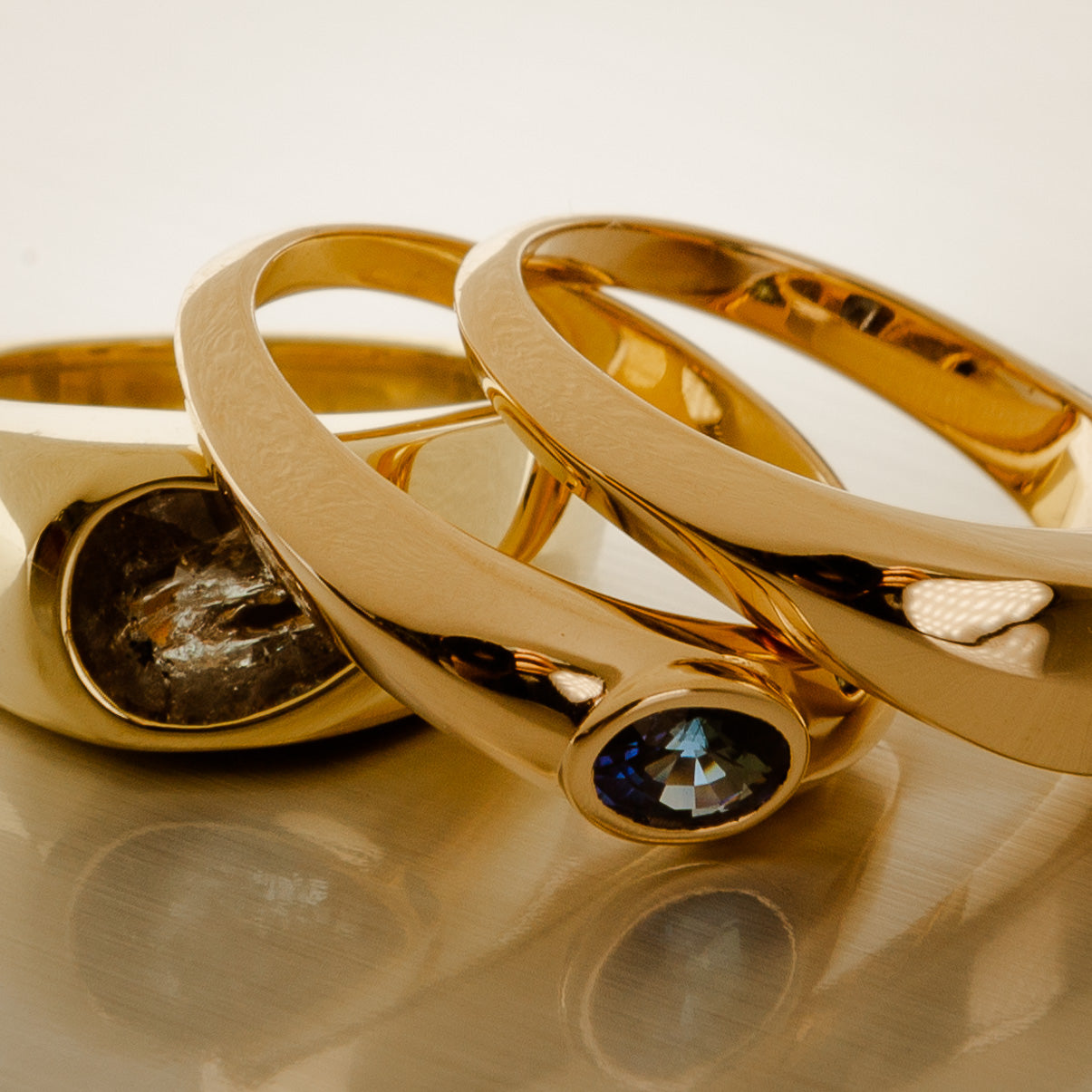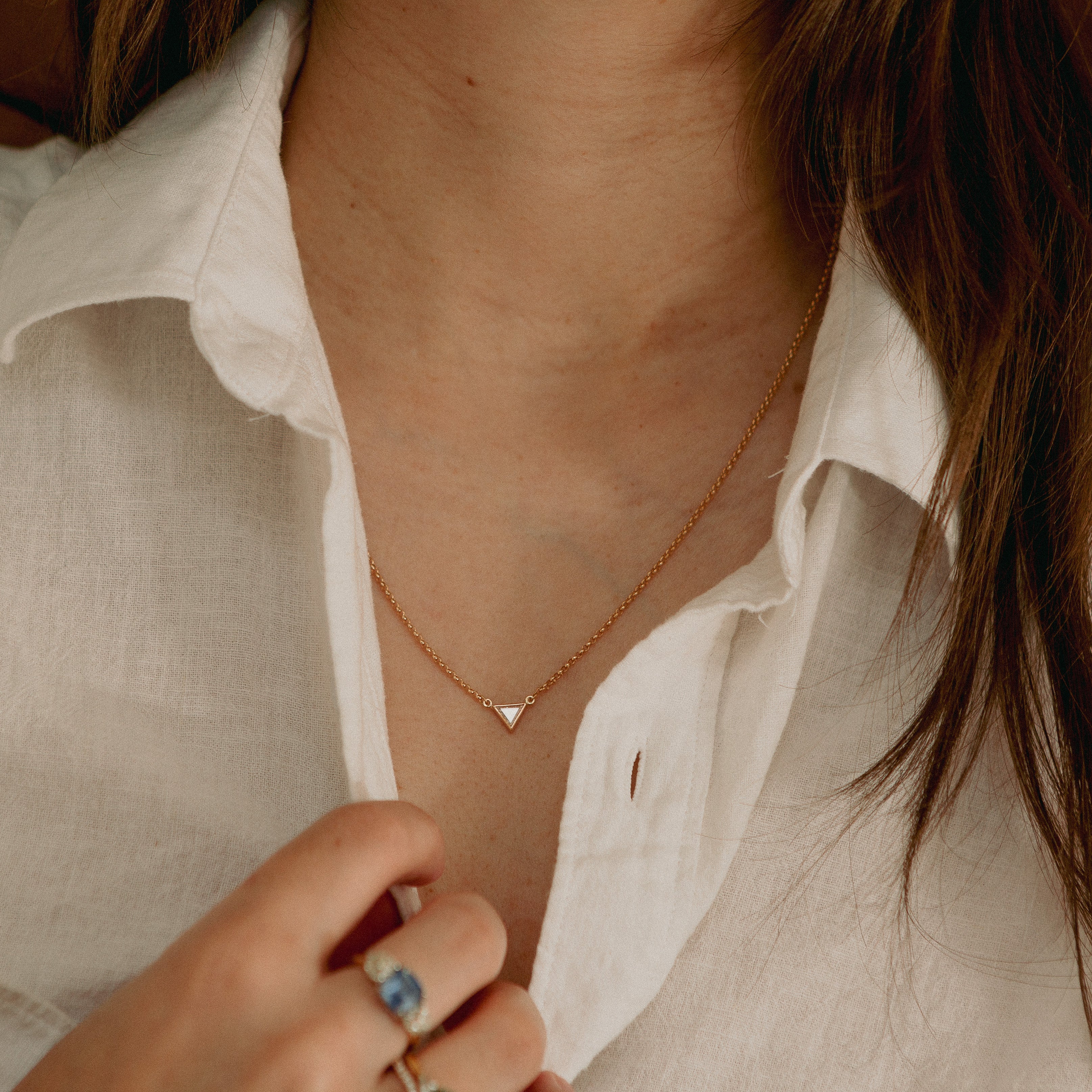At Stórica, we pride ourselves on transparancy when it comes to sharing the origns of our materials. We want you to be confident that your jewelry reflects your values for social and environmental responsiblity.
Our Metals
Our jewelry is made entirely of precious metals including fine silver, sterling silver, 14k, 18k and 22k gold and platinum. We do not work in plated, gold-fill or base metals.
Our Metal Sources
For the majority of our jewelry, we source 100% post-consumer recycled metals from Hoover & Strong and Stuller. Both of these companies offer SCS-certified post consumer recycled metals to jewelers.
Recycled metals are wonderful, but we know that they will never replace mining operations. For that reason, it is important to support organizations who are working to improve environmental and labor standards in metal mining. For customers who prefer to know the origin of their metals, we are able to source Fairmined Gold. Fairmined is an assurance label that denotes gold that was mined by artisanal and small-scale mining organizations who meet world leading standards for responsible practices.
Talk To Me About Karats
Gold, one of the most precious metals, is often alloyed with other metals to increase its durability and alter its color. The purity of gold is measured in karats, denoted by the symbol "k" or "kt". Here's a breakdown of the most common karats:
24 Karat Gold (24k): This is the purest form of gold, consisting of 99.9% gold and minimal alloy metals. It has a rich, deep yellow hue and is very soft and malleable, making it unsuitable for most jewelry applications but highly prized for investment purposes.
22 Karat Gold (22k): Slightly less pure than 24k gold, 22k gold contains 91.7% gold and is alloyed with other metals such as copper or silver. It retains a vibrant yellow color and is commonly used in traditional and cultural jewelry pieces, as well as for investment purposes.
18 Karat Gold (18k): Comprising 75% gold and 25% alloy metals, 18k gold strikes a balance between purity and durability. It is popular for high-end jewelry pieces due to its rich color and increased resistance to scratching and tarnishing.
14 Karat Gold (14k): Widely used in mainstream jewelry, 14k gold consists of 58.3% gold and 41.7% alloy metals. It offers excellent durability while still maintaining a significant gold content, making it a popular choice for engagement rings, wedding bands, and everyday jewelry.
10 Karat Gold (10k): The most durable and affordable option, 10k gold contains 41.7% gold and 58.3% alloy metals. While it has a lower gold content compared to higher karatages, it is prized for its strength and resistance to wear and tear, making it suitable for everyday wear.
When selecting gold jewelry, it's essential to consider both the karatage and the alloy composition to ensure the piece meets your preferences for color, durability, and budget. Whether you prefer the rich luster of high karat gold or the practicality of lower karatages, understanding the differences in gold karats allows you to make informed choices when investing in precious jewelry pieces.
What about Color?
Gold, in its pure form, is naturally yellow. However, when alloyed with other metals, it can take on a variety of colors, each with its own unique properties and aesthetic appeal. Here are the most common colors of gold:
Yellow Gold: This is the natural color of gold and is the result of combining pure gold with alloy metals such as copper and silver. Yellow gold has a warm, rich hue that is timeless and classic, making it a popular choice for all types of jewelry, from engagement rings to necklaces and bracelets.
White Gold: To achieve a white appearance, gold is alloyed with white metals such as nickel, palladium, or zinc, and often plated with rhodium for added brightness. White gold has a cool, silvery-white tone that complements diamonds and colored gemstones beautifully. It's a versatile option for those who prefer a more contemporary look.
Rose Gold: Also known as pink or red gold, rose gold is created by alloying gold with copper and a small amount of silver. The result is a warm, rosy hue that exudes romance and femininity. Rose gold has surged in popularity in recent years, adding a touch of vintage charm to modern jewelry designs.
Green Gold: Green gold, also referred to as electrum, is a rare and unique alloy of gold and silver. It has a subtle greenish tint that sets it apart from traditional yellow gold. While less common in jewelry, green gold can add a distinctive and eye-catching element to bespoke pieces.
The Other White Metals
Gold is great, but for those of you who love white metals, there are a couple of other optons.
Sterling Silver
Sterling silver is a popular and versatile metal alloy used in jewelry. It consists of 92.5% pure silver and 7.5% of other metals, typically copper, which provides strength and durability to the silver. The term "sterling" has historical origins, dating back to medieval England when silver pennies were first coined from this alloy. Over time, the term came to signify high-quality silver of consistent purity, hence the use of "sterling" to describe this particular silver alloy.
Sterling silver is a popular choice for jewelry due to its affordability and versatility. However, despite its durability, sterling silver jewelry may tarnish over time due to exposure to air and moisture. Regular cleaning and proper storage can help maintain its shine and prevent tarnishing.
Platinum
Platinum is a dense, precious metal with a naturally white color. It is one of the most durable and resilient metals used in jewelry. It is highly resistant to tarnishing, corrosion, and wear, making it an excellent choice for everyday wear, especially for rings and other pieces subjected to frequent use. Platinum is also naturally hypoallergenic, making it a great choice for individuals with sensitive skin or metal allergies.
While platinum is highly durable and resistant to corrosion and tarnishing, it is not immune to scratching and wear. With regular use, platinum jewelry may develop a matte finish or fine scratches on its surface, giving it a subtle, lived-in appearance known as the platinum patina.








